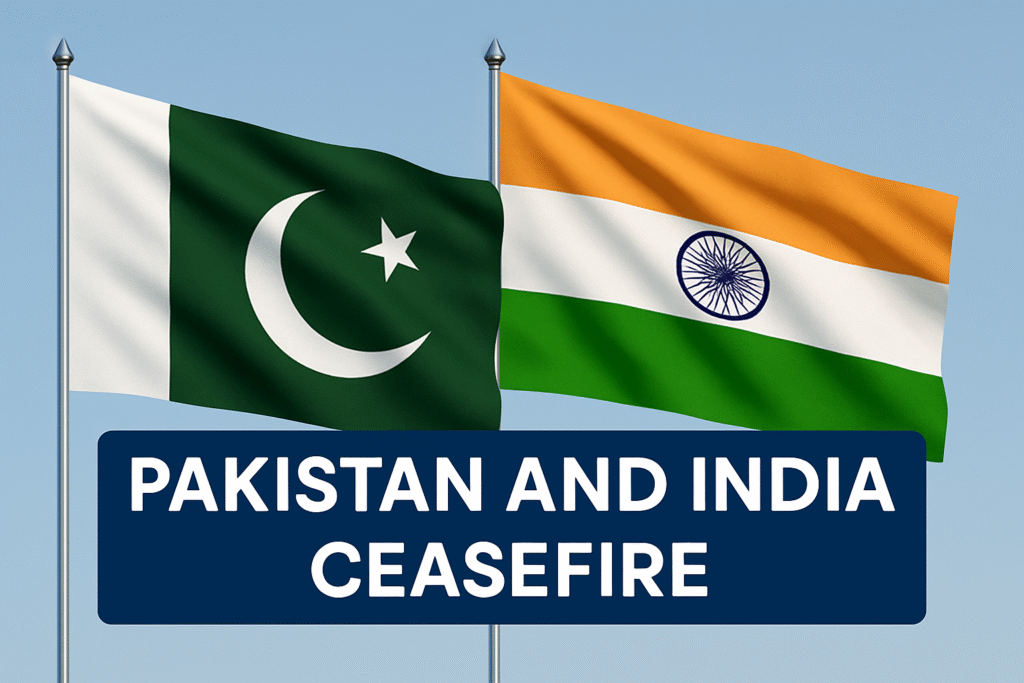
Ceasefire

Pakistan and India – Ceasefire
The relationship between Pakistan and India has long been defined by conflict, mistrust, and brief intervals of diplomacy. As two nuclear-armed neighbors with a shared yet deeply divided history, every shift in their engagement — whether hostile or conciliatory — echoes across South Asia and beyond. One of the most significant and hopeful developments in recent years has been the reaffirmation of the ceasefire agreement along the Line of Control (LoC) in February 2021, a pact that remains a cornerstone for regional peace.
A History of Tension
Since the partition in 1947, Pakistan and India have fought three full-scale wars and numerous skirmishes, primarily over the disputed region of Jammu and Kashmir. The LoC, established after the 1971 war, has often been the epicenter of these confrontations, with frequent violations leading to casualties among both military personnel and civilians.
In the past decade, ceasefire violations had reached alarming levels, with thousands of incidents reported each year. The cycle of violence not only strained diplomatic relations but also inflicted immense suffering on border communities.
The 2021 Ceasefire Agreement
On February 25, 2021, in a surprise joint statement, Pakistan and India agreed to a “strict observance” of all agreements concerning the ceasefire at the LoC and other sectors. This announcement, brokered quietly through backchannel diplomacy, marked a rare thaw in otherwise frosty relations.
Both countries committed to maintaining peace and addressing each other’s core issues in a “mutually agreeable manner.” Though not a comprehensive peace treaty, this agreement reflected a willingness to deescalate tensions — a critical move at a time when both nations were grappling with domestic challenges, including economic strains and public health crises.
Why This Ceasefire Matters
1. Humanitarian Relief: Reduced hostilities at the border have brought much-needed relief to residents of border villages who have lived under the constant threat of shelling and displacement.
2. Diplomatic Openings: The ceasefire has the potential to pave the way for broader dialogue on trade, people-to-people contact, and the Kashmir dispute.
3. Regional Stability: South Asia is a volatile region with complex interdependencies. A sustained ceasefire between its two largest rivals contributes to stability not only bilaterally but also for neighboring countries and regional alliances.
4. Focus on Internal Development: With fewer resources and attention devoted to military tensions, both countries can prioritize domestic development and economic revival.
Challenges to Sustaining the Peace
While the ceasefire is a positive development, sustaining it requires political will, trust-building, and consistent engagement. Sporadic incidents of violence, nationalist rhetoric, and unresolved core issues — particularly Kashmir — continue to pose significant risks.
Moreover, without a structured diplomatic roadmap, the ceasefire risks becoming another temporary lull rather than a step toward lasting peace.
The Way Forward
Peace between Pakistan and India cannot be built overnight. But even small measures — like respecting a ceasefire — matter profoundly. Confidence-building initiatives, resumption of formal diplomatic talks, and greater cross-border engagement at the civil society level are essential next steps.
The world is watching, and millions on both sides of the border are hoping. The 2021 ceasefire reaffirmation has shown that despite decades of hostility, dialogue is still possible. The challenge now is to transform that possibility into sustained peace.



